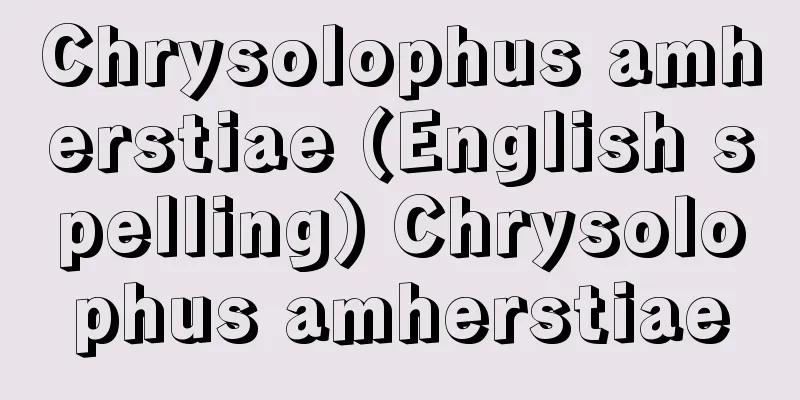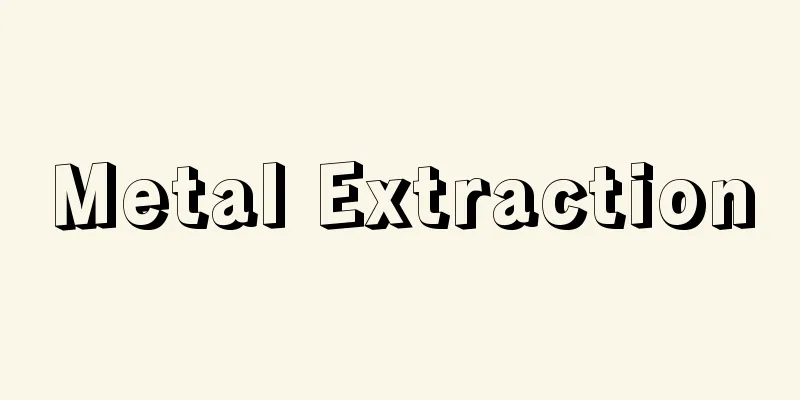Sewerage - Gesuido (English spelling)
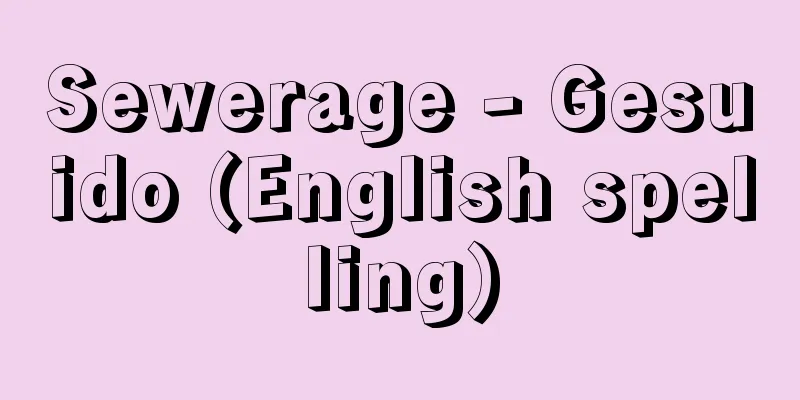
|
A general term for structures that remove sewage, relay pumping stations, and treatment facilities, which ultimately discharge the sewage into public waters to protect the aquatic environment. It does not include irrigation and drainage facilities or septic tanks. Sewage is a general term for wastewater resulting from human life and production activities, as well as rainwater and melted snowwater, and includes household wastewater, flush toilet wastewater, and wastewater from factories and business establishments (schools, government offices, hospitals, stations, offices, public facilities, etc.). [Saburo Matsui] The role of sewerageSewers function to remove rainwater from urban areas, and in Japan, where rainfall is high, they play an essential role in preventing flooding along with drainage channels. In addition, when household wastewater and wastewater from factories and businesses stagnate in residential areas or cities, they become a breeding ground for mosquitoes and flies, which emit foul odors and worsen the living environment. Furthermore, to create a comfortable living environment, flushing of human waste is necessary, and sewer systems function to remove all of this wastewater at once. As populations become more concentrated in cities and industrial production activities increase, the amount of pollutants discharged into public water bodies increases, causing water pollution, and sewage treatment is now being carried out at the end of the sewer system. By preventing pollution of public water bodies, sewer systems not only conserve water sources and agricultural, fishery and industrial water, but also make recreational activities such as swimming, fishing and boating possible, as well as the preservation of the natural environment. Treated sewage is also reused for industrial water, greywater, agricultural water and for maintaining river channels. Another important benefit of sewer systems is that the removal and final treatment of wastewater within cities prevents infectious gastrointestinal diseases such as cholera, typhoid, paratyphoid and dysentery. [Saburo Matsui] History of the Sewerage SystemAncientThe oldest sewer system is said to date back to around 3000 B.C. The sewer system discovered in the ruins of the Acadian palace in southern Mesopotamia was an open channel made of stone and brick. The ruins of the city of Mohenjo-daro in the Indus River basin from the same period had an orderly urban plan, with brick sewers remaining on both sides of the road. There are traces of manholes installed at regular intervals in the sewer channels, and a system of separating sewage pipes that collected flush toilet effluent and household wastewater from storm water pipes that collected rainwater was already in place. In the Roman era, cities were systematically developed, and sewer construction developed in the colonies of the Roman Empire. The most famous sewer is the Cloaca Maxima, built in the Forum Valley between 616 and 578 BC. It is a huge stone pipe with a semicircular arch, and is still used today as a storm drain. Sewers were considered important from the beginning of the construction of ancient cities, but with the fall of the Roman Empire, the sanitary environment of the cities was completely neglected, and the city entered the Dark Ages of the Middle Ages, when epidemics were rampant. [Saburo Matsui] Development of modern sewerage systemsThe Industrial Revolution and the accompanying expansion of cities were what prompted the rise of modern sewers. As Britain was an early industrializer, modern sewers were first seen in Britain. The new class of workers concentrated in cities lived in extremely poor conditions. In Manchester, there was no sewer system, so the roads had poor drainage, and in the city center there was only one toilet for every 380 residents, and sewage and polluted wastewater was constantly overflowing onto the streets. The city's rivers were black and polluted with wastewater from dye factories, gas companies, tanneries, and other sources. Most industrial cities in Britain were in a similar situation. The cholera epidemic of 1831 was a major turning point, and thanks to the efforts of physician Edwin Chadwick (1800-90), the Public Health Act (1848) was enacted, and water supply and sewerage services were started. London popularized flush toilets and developed a combined sewer system under the guidance of engineer Joseph Bazalgette (1819-91) to separate domestic sewage, industrial wastewater, and rainwater. However, because this system involved collecting sewage along the Thames and discharging it downstream in a concentrated manner, as this system spread throughout the city, water pollution downstream became worse, making it necessary to treat the sewage with chemical precipitation. Like London, construction of Paris' sewers began in 1833 as a result of a cholera epidemic. In Germany, construction of sewers in Hamburg began after the Great Fire of 1842. In the United States, the first sewers were built in Philadelphia in 1801 and in Brooklyn, New York in 1857. [Saburo Matsui] History of Sewerage in JapanIn Japan, the use of human waste as agricultural fertilizer has been well developed since ancient times, and up until the Edo period, cities had relatively well-developed drainage channels and river water pollution was not significant, so construction of sewerage systems was delayed. As cities modernized, the population of Tokyo, Osaka, and other cities grew rapidly, and after the Great Fire of Ginza, Tokyo in 1872 (Meiji 5), the sewers on both sides of the streets were remodeled to a Western style at the same time as the streets were repaired. A cholera epidemic in Tokyo in 1877 made the need for a sewer system clear, and from 1884 to 1886, following the suggestion of Dutch engineer Johannes De Rijke (1842-1913), a separate sewer system was laid in Kanda Kajicho, Tokyo, and other areas, marking the first modern sewer system in Japan. Around the same time, a brick sewer system was laid in the foreign settlement in Yokohama. Cholera and other infectious diseases killed hundreds of thousands of people throughout the country during the Meiji era, but in response, the Water Supply Act was enacted in 1890 to promote the spread of water supply. Thanks in part to advances in bacteriology for infectious diseases, the death rate dropped dramatically, but the spread of sewerage systems, which should have been developed in conjunction with water supply systems, did not progress despite the efforts of Nagayo Sensai, Goto Shinpei, British engineer William K. Burton (1855-1899), and others. The Sewerage Act was enacted in 1900 (Meiji 33). The first modern sewerage system built by Japanese engineers was started in Sendai in 1899 and completed in 1913 (Taisho 2). Around the same time, construction also began in Hiroshima (construction began in 1908), Osaka, Nagoya, and Tokyo (all in 1911). The oldest sewage treatment system in Japan was the trickling filter method at the Mikawashima Treatment Plant in Tokyo in 1922. In 1930 (Showa 5), the Horidome and Atsuta Treatment Plants in Nagoya were the first in Japan to apply the activated sludge method (accelerated sludge method). Burton's original sewerage plan was a separate sewerage system, but after Nakajima Eiji (1858-1925) revised it to a combined system, cities such as Hakodate, Okayama, Akashi, Matsuyama, Aizuwakamatsu, Fukushima, and Oita built combined sewerage systems. However, due to the Meiji policy of enriching the country and strengthening the military, and the military-first policies of the Taisho and Showa eras, investment in social capital in sewerage construction ended up being insufficient. By 1940, construction had begun in 40 cities, and only six cities and one town had treatment plants. The post-World War II reconstruction and rapid economic growth caused rapid water pollution in rivers nationwide, which led to the recognition of the need for sewerage construction. Through the revision of the Sewerage Act (1958), the initiation of the First Sewerage Development Five-Year Plan (1963), the Basic Law for Pollution Control (abolished with the enactment of the Basic Law for the Environment in 1993) and the Water Pollution Prevention Law (1970), the sewerage treatment population coverage rate exceeded 50% in 1994 (Heisei 6), and the Sewerage Development Five-Year Plan was revised to the Eighth Sewerage Development Seven-Year Plan in 1996. Furthermore, the construction of sewerage systems was incorporated into the Priority Plan for Social Capital Development in 2003 (Heisei 15), and the coverage rate rose to 78.3% (approximately 99.82 million people) at the end of fiscal year 2016. However, there is a disparity between large cities and medium-sized cities, towns, and villages, with the coverage rate in cities and towns with a population of less than 50,000 remaining at 50.2% at the end of the same fiscal year. [Saburo Matsui] How the Sewer System WorksA system in which wastewater and rainwater are discharged together and transported to a sewage treatment plant is called a combined sewer system. In this system, when the amount of rainwater exceeds 2 to 3 times the amount of wastewater on a sunny day, the excess amount of sewage is discharged directly into public waters through a storm drain, and the remainder is led to a treatment plant. However, in urban areas, the water pollution load caused by direct discharge during rainy weather can no longer be ignored, and a review of the combined sewer system is required. For example, in Osaka City, initial rainwater is treated by settling in a stormwater retention pond (Hirano and Ichioka Treatment Plants). A separate sewer system is a system in which wastewater and rainwater are discharged separately and all the wastewater is led to a sewage treatment plant, but if rainwater is discharged directly, the pollution load from non-specific pollution sources such as roads, gutters, and roofs increases, and problems with stormwater treatment measures are occurring in cities around the world. However, the reality is that measures to address this issue are lagging behind. When wastewater is discharged from factories and businesses into the sewer system, pretreatment (installation of abatement facilities) is required if it is likely to damage the sewerage system, impede the treatment function of the final treatment plant, or make it difficult to make the treated water quality from the treatment plant comply with the discharge water standards. For example, the Sewerage Act sets standards for acceptance into the sewer system for harmful substances such as mercury, cadmium, arsenic, lead, and cyanide, as well as water quality items such as pH (acid, alkali), oil, water temperature, high BOD (abbreviation of biochemical oxygen demand), and high COD (abbreviation of chemical oxygen demand). [Saburo Matsui] Sewage TreatmentSediment and fine particles in the sewage that flows into the final treatment plant are removed by settling in a grit basin and a primary sedimentation basin. This is called primary treatment. Organic pollutants in the sewage are then biologically treated using microorganisms. Treatment methods include the activated sludge method, trickling filter method, rotating disk method, and submerged filter method, and the treated water is separated from the microbial sludge in the final sedimentation basin. This is generally called secondary treatment. In Japan, secondary treatment is considered high-grade treatment, but more advanced treatment is required depending on the public water area where the sewage is discharged. For example, because total COD regulations have been implemented in closed water areas such as the Seto Inland Sea, Tokyo Bay, and Ise Bay, stricter BOD and COD standards are applied depending on the individual treatment plant, and nitrogen and phosphorus removal is required as a measure against eutrophication. In such cases, this is called tertiary treatment (advanced treatment) and is carried out at sewage treatment plants in the Lake Biwa basin. The sludge generated in the primary and final settling tanks is treated by thickening, anaerobic digestion (decomposition of organic matter by anaerobic bacteria and generation of methane gas, etc.), dehydration, incineration, and landfill. The issue of sludge treatment and disposal in sewage treatment is becoming increasingly important. Power generation from recovered methane gas can cover about 10-20% of the electricity consumed by sewage treatment plants. This method has been used in Europe and the United States for a long time, and research and development has progressed in Japan as well, with some treatment plants using it. There are some methods of returning dehydrated sludge to agricultural use, but the effects of the heavy metals in the sludge on cultivated plants and on the human body directly and indirectly through food must be carefully considered in the future before sludge is used in agriculture. Incineration is the main method of sludge treatment. In some cases, the incineration ash is landfilled, and in cases where landfilling is difficult, the incineration ash is used as material for road paving concrete blocks, or melted at high temperatures and reused as construction material. Although incineration and melting of sludge increases the cost of sewage treatment, this will become increasingly important in the future, given that landfill disposal of waste is difficult in Japan's small land area and because it destroys harmful organic substances (PCBs, dioxins, environmental hormones, etc.) that are concentrated in sludge. [Saburo Matsui] Sewerage PlanningIn planning a sewerage system, it is necessary to determine the amount of wastewater and rainwater in the sewage removal area, the location of the sewage removal method (combined or separated), the relay pumping station, the location of the rainwater outlet, the size of the facility, and the method of sewage treatment. The amount of wastewater is roughly the same as the amount of water supply, but it is calculated taking into account the factors such as factories, business establishments, daytime population movement, and seasonal population fluctuations in tourist destinations. The amount of rainwater is calculated by multiplying the rainfall and drainage area by the runoff coefficient. If the expected amount of rainfall is small, the drainage capacity of the sewerage system is insufficient and flooding occurs. In the past, the target was rainfall equivalent to a return period of 3 to 5 years, but recently the design has been improved to withstand rainfall with a return period of 5 to 10 years. However, there is a risk that the rainfall conditions on which the probability rainfall intensity (the probability value of the amount of rainfall that falls per unit time) is based may change due to the effects of global warming, and there is concern that the occurrence of situations that exceed the past rainfall conditions may occur. [Saburo Matsui] Types of SewerageIn Japan, sewerage systems are broadly divided into public sewerage systems, river basin sewerage systems, urban sewerage systems and other public sewerage systems under the law. In addition to these, there are also small-scale private sewerage systems called combined treatment systems in housing complexes and housing developments. Public sewerage systems are managed by local governments, and mainly remove sewage from urban areas (urban planning areas) and have their own final treatment plants or are connected to river basin sewerage systems. River basin sewerage systems are sewerage systems that span the areas of two or more cities, towns, and villages, and consist of a sewer trunk line to which the public sewerage systems of each city, town, and village are connected, a pumping station, and a final treatment plant, and generally have a larger sewage removal area. Urban sewerage systems are sewerage systems managed by local governments mainly for removing sewage from urban areas, and are a transitional form without a final treatment plant for the purpose of discharge, and are used as storm water channels after the final treatment plant is established. In addition, there are designated public sewerage systems that mainly target groups of factories and business establishments, and designated environmental sewerage systems that aim to protect the environment in tourist destinations and other settlements. In cases where the size of a settlement is small (less than 1,000 people), the Ministry of Land, Infrastructure, Transport and Tourism is taking the lead in developing small-scale sewerage systems. Meanwhile, the Ministry of Agriculture, Forestry and Fisheries is also promoting the construction of rural settlement wastewater treatment facilities (rural sewerage systems) as part of its efforts to promote rural areas, but these are targeted at areas where urban public sewerage systems cannot be developed. [Saburo Matsui] Problems facing sewerage systemsAs mentioned above, the sewerage coverage rate of the population in Japan has only reached 60% as of March 2000, and further investment in construction (approximately 1 trillion yen per 1% increase in coverage rate in 1982, and approximately the same amount in 2000) will be required, increasing the financial burden on the national and local governments. In addition, maintenance costs will be incurred with the start of sewage treatment, and new technologies based on energy conservation and energy creation are required to reduce and save on these costs. As a measure against eutrophication in closed water areas, it is necessary to introduce tertiary treatment to remove nitrogen and phosphorus and reduce COD, and it is also important to take measures against non-point pollution sources by draining rainwater. Since the sewage removal area of river basin sewerage systems is large, the issue of management and operation (cooperation between multiple municipalities, fairness of cost burden, etc.) is an important aspect. Furthermore, since water within the river basin is removed by artificial systems such as water supply and sewerage systems, there are cases where the low water maintenance water volume of the main river decreases, and there are cases where this conflicts with water rights issues. In such cases, it is necessary to actively promote the reuse of sewage treatment water. Treated sewage is reused as industrial water at the Mikawashima Treatment Plant in Tokyo and the Sennen Treatment Plant in Nagoya, but the amount is limited. In buildings such as the Sunshine Building in Ikebukuro, Tokyo, a completely greywater system is implemented within the building. Treated water from the Tamagawa Upper Treatment Plant is piped to the Tamagawa Aqueduct for environmental conservation purposes, helping to revive the Tamagawa Aqueduct from the Edo period and preserve cultural properties. As the amount of treated sewage increases, the treatment and disposal of generated sludge is becoming an increasingly serious problem. While efforts are being made to reuse sewage for agricultural purposes, future technological challenges remain, such as improving the efficiency of energy used in incineration (for example, co-incineration with urban waste in Kanazawa) and making effective use of incineration ash and molten slag (for construction materials, etc.). Concerning the achievement rate of the environmental standard for water quality, although there has been an improvement in the river environment (BOD index) since the Water Pollution Prevention Law was enacted in 1970, the achievement rate of the environmental standard was about 81.5% as of March 1999. The achievement rate of the environmental standard for ocean areas (COD) was 74.5%, and the achievement rate of the environmental standard for lakes and ponds was about 45.1%, and there has been no improvement since the 1970s. Improvements are still necessary in areas such as factory wastewater, agricultural wastewater, and road drainage during rainy weather, but it is problematic that there has been no improvement in the water quality of public water areas despite the large amount of sewerage budget of almost 50 trillion yen since the first five-year plan from 1963. In addition, the problem of recovering agricultural fertilizers such as nitrogen, phosphorus, and potassium, and the relationship between sewerage and harmful chemicals such as environmental hormones and carcinogens are major issues for the future. It can be said that the challenge of sewerage in the 21st century is to aim for a resource-circulating society. [Saburo Matsui] "Easy-to-understand Civil Engineering Lectures 15: Sanitary Engineering" by Ken Goda, Isamu Tsugo, and Takeo Yamamoto (1969, Shokokusha) " "Iwanami Lectures: Global Environmental Studies 4: Changes in Water and Material Circulation Systems" edited by Eitaro Wada and Tetsuzo Yasunari (1999, Iwanami Shoten) [Reference items] | | | | | | | | | | | |Sedimentation |On flat land, sewer pipes are buried at an incline to allow the water to flow naturally. When the buried pipes reach a certain depth, pumping stations pump the sewage up to the surface, allowing it to flow naturally again. For long distances, this process is repeated to allow the sewage to flow to the treatment plant. The diagram shows an example of how a sewage treatment plant works, and the structure and name of the treatment facility may vary depending on the region. ©Shogakukan "> How sewage treatment works Source: Shogakukan Encyclopedia Nipponica About Encyclopedia Nipponica Information | Legend |
|
下水を排除する構造物、中継ポンプ場、処理施設などの総称であり、最終的には公共水域に排出して水質環境の保全を図るもの。灌漑(かんがい)・排水施設や屎尿(しにょう)浄化槽は含まない。人間の生活と生産活動とに起因する汚水および雨水や融雪水の総称が下水であり、汚水は家庭雑排水、水洗便所排水と工場、事業場(学校、官庁、病院、駅、事務所、公共施設など)の排水を含む。 [松井三郎] 下水道の役割下水道は都市域内の雨水を排除する機能をもち、降雨量の多い日本では排水路とともに浸水防除に欠かせない位置を占める。また、家庭雑排水や工場、事業所などの排水が住宅地や都市内に停滞するとカやハエなどの発生源となり、悪臭を発し居住環境を悪化させる。さらに快適な生活環境づくりには屎尿の水洗化が必要とされ、下水道はこれらの汚水をまとめて排除する機能をもつ。 都市への人口集中と工場の生産活動の増大に伴い公共水域に排出される汚濁物質量が増加し、水質汚染が進行したために下水道の終末において下水処理が行われている。下水道が公共水域の汚濁を防止することにより、上水道源、農業・水産・工業用水を保全するのみならず、水泳、魚釣り、ボート遊びなどのレクリエーションや自然環境保全も可能となる。また、処理下水は、工業用水、中水道、農業用水や河川水路の維持用水に再利用される。下水道の見落とせないもう一つの効果は、都市内における汚水の排除と終末処理とが、コレラ、腸チフス、パラチフス、赤痢などの消化器系伝染病を予防していることである。 [松井三郎] 下水道の歴史古代最古の下水道は紀元前3000年ごろにまでさかのぼるといわれる。南メソポタミアのアカディアン宮殿の遺跡で発見された下水道は開渠(かいきょ)で、石とれんが造である。同時代のインダス川流域のモヘンジョ・ダーロ都市遺跡では整然とした都市計画が行われ、道路両側にれんが造の下水道が残されている。下水溝の一定間隔にマンホールを設置した跡がみられ、水洗便所排水と家庭雑排水を集める汚水管と雨水を集める雨水管とを別にした分流方式をすでに実現していた。 ローマ時代には系統的な都市づくりが行われ、ローマ帝国領内の植民都市をも含めて下水道建設が発達した。もっとも有名な下水道は前616~前578年にフォーラム谷に建設されたクロアカ・マキシマCloaca Maximaで、これは半円形アーチの巨大な石造管渠であり、現在でも雨水排除下水管として利用されている。古代諸都市の建設において下水道は最初から重要視されていたが、ローマ帝国滅亡とともに諸都市の衛生環境はまったく顧みられなくなり、疫病が流行する中世の暗黒時代に入った。 [松井三郎] 近代的下水道の発達近代的下水道の勃興(ぼっこう)を促したものに産業革命とそれに伴う都市の膨張がある。イギリスが早く工業化を進めたこともあり、近代下水道の出発はイギリスにみられる。都市に集中した新しい階級の労働者は、きわめて劣悪な環境で生活していた。マンチェスターでは下水道がないので道路の水はけが悪く、市の中心部で380人の住民に対し便所が一つしかなく、汚水や汚濁物が道路につねにあふれていた。市内河川は、染色工場、ガス会社、皮なめし工場などからの排水で真っ黒に汚染していた。イギリスの工業諸都市のほとんどがこれと同様の状況にあった。1831年のコレラ大流行を大きな契機に医師チャドウィックEdwin Chadwick(1800―90)の活躍により公衆衛生法Public Health Act(1848)が制定され、上下水道などの事業が開始された。ロンドンは水洗便所を普及させて、家庭汚水、工場排水、雨水をともに排除する合流式下水道を技師バザルジェットJoseph Bazalgette(1819―91)の指導で整備したが、下水をテムズ川に沿って遮集し下流で集中放流する方法であったために、整備が市街地で広がるにつれ、下流の水質汚染が進行し、そのため薬品沈殿の下水処理が必要となった。 パリの下水道もロンドンと同じくコレラ流行の結果、1833年に建設に着手した。ドイツではハンブルクの下水道建設が1842年の大火後に始まった。アメリカでは1801年のフィラデルフィア、57年ニューヨークのブルックリン地区の建設が最初である。 [松井三郎] 日本の下水道の歴史日本では古くから屎尿を農業肥料として活用する方法が発達しており、また江戸時代までの諸都市では用排水路が比較的整備され、河川の水質汚染も顕著ではなかったので下水道建設が遅れた。近代化とともに東京、大阪など諸都市の人口増加が急速に進み、1872年(明治5)東京・銀座の大火後、街路修築と同時に、街路両側の下水溝を西洋風に改造した。1877年に東京にコレラが大流行して下水道の必要性が認識され、1884~1886年にオランダ人技師デ・レーケJohannes De Rijke(1842―1913)の意見により東京・神田鍛冶(かじ)町などに分流式下水道を敷設したのが日本の近代下水道の最初である。同じころに横浜外国人居留地にもれんが造下水道が敷設された。コレラその他の伝染病は明治時代を通じて全国で数十万人の死亡者を出したが、これに対して1890年に水道法が制定され、上水道の普及が図られた。伝染病に対する細菌医学の進歩もあり、これらの結果、死亡率が激減したが、上水道と一体に整備されるべき下水道の普及は、長与専斎(ながよせんさい)、後藤新平、イギリス人技師バルトンWilliam K. Burton(1855―1899)らの努力にもかかわらず進まなかった。下水道法の制定は1900年(明治33)のことである。 日本の技術者による最初の近代的下水道は、仙台市において1899年に着工し1913年(大正2)に完成した。このころ広島(1908年着工)、大阪、名古屋、東京(いずれも1911年着工)の諸都市も建設を始めた。日本におけるもっとも古い下水処理は1922年の東京・三河島処理場の散水濾床(さんすいろしょう)法によるものである。1930年(昭和5)名古屋の堀留と熱田両処理場は活性汚泥法(促進汚泥法)を初めて日本で適用した。バルトンの当初の下水道計画は分流式下水道であったが、中島鋭治(1858―1925)が合流式に改めて以後、函館(はこだて)、岡山、明石(あかし)、松山、会津若松、福島、大分などの諸都市は合流式下水道を建設した。しかし、明治の富国強兵政策、大正・昭和の軍事優先の政策により、下水道建設への社会資本投下は不十分に終わった。1940年までに40都市が建設着工、処理場をもつのは6市1町であった。 第二次世界大戦後の復興と高度経済成長とは全国河川の水質汚濁を急速に進行させ、それを契機に下水道建設の必要性が認識されるようになった。下水道法改正(1958)、「第一次下水道整備五箇年計画」開始(1963)、公害対策基本法(1993年環境基本法制定に伴い廃止)をはじめ水質汚濁防止法の制定(1970)を経て、1994年(平成6)には下水道処理人口普及率は50%を突破、「下水道整備五箇年計画」は1996年度より「第八次下水道整備七箇年計画」に改定された。さらに2003年(平成15)からは社会資本整備重点計画のなかに下水道の敷設が組み込まれ、普及率は2016年度末には78.3%(約9982万人)にまで上昇した。しかし、大都市と中市町村とは格差があり、人口5万人未満の市町村の普及率は同年度末で50.2%にとどまっている。 [松井三郎] 下水道の仕組み汚水と雨水とをまとめて排除し下水処理場へ運ぶ方式を合流式下水道という。この方式では、雨水量が晴天時汚水量の2~3倍を超えたとき、超えた下水を雨水吐きを通じて直接公共水域に放流し、残りを処理場に導く。しかし都市域で雨天時の直接放流による水質汚濁負荷量が無視できなくなり、合流式下水道の見直しが必要となっている。たとえば大阪市では、初期雨水を雨水滞水池で沈殿処理している(平野、市岡処理場)。汚水と雨水とを別々に排除し、汚水を全量下水処理場に導く方式が分流式下水道であるが、雨水をそのまま放流すると道路、側溝、屋根など非特定汚染源による汚濁負荷量が増大し、雨水処理対策の問題が世界の諸都市で発生している。しかし、その対策は遅れているのが実情である。 工場や事業場から汚水を下水道に排出する場合、下水道施設を損傷したり、終末処理場の処理機能を妨げたり、処理場からの処理水質を放流水基準に適合させることが困難になるおそれのある汚水は、前処理(除害施設の導入)が必要である。たとえば水銀、カドミウム、ヒ素、鉛、シアンなどの有害物質やpH(酸、アルカリ)、油分、水温、高BOD(biochemical oxygen demandの略、生物化学的酸素要求量)、高COD(chemical oxygen demandの略、化学的酸素要求量)などの水質項目についての下水道受入れ基準が下水道法により設定されている。 [松井三郎] 下水処理終末処理場に流入した下水中の土砂類や細かい粒子は、沈砂池および最初沈殿池で沈殿除去される。ここまでを一次処理とよぶ。さらに下水中の有機性汚濁物質に微生物を利用した生物学的処理を施す。処理方法には活性汚泥法、散水濾床(ろしょう)法、回転円板法、浸積濾床法などがあり、処理水を最終沈殿池で微生物汚泥と分離する。ここまでを一般に二次処理とよぶ。日本では二次処理までを高級処理としているが、放流先の公共水域によってはさらに進んだ処理が必要になる。たとえば瀬戸内海、東京湾、伊勢(いせ)湾などの閉鎖水域でCOD総量規制が実施されたために、個々の処理場によってはより厳しいBOD、COD基準が適用され、富栄養化対策として窒素、リンの除去が必要となる。このような場合、三次処理(高度処理)とよばれ、琵琶(びわ)湖の流域下水道処理場などで行われている。 最初沈殿池と最終沈殿池とで発生した汚泥には、濃縮、嫌気性消化(嫌気性細菌による有機物分解とメタンガスなどの発生)、脱水、焼却、埋立ての処理処分がなされる。下水処理における汚泥の処理処分問題がますます重要になりつつある。メタンガス回収による発電で、下水処理場の消費電力の1~2割程度をまかなえる。欧米では古くからこの方式が実用化されており、日本でも研究開発が進み、一部の処理場で実用化されている。脱水汚泥を農業利用に還元する方法も一部実施されているが、汚泥中の主として重金属の栽培植物に与える影響や、食物を通じて直接間接に人体に及ぼす影響については、今後注意深く検討し、汚泥の農業利用を実施していく必要がある。汚泥処理の中心は焼却である。焼却灰を埋立てる場合と、埋立てが困難な場合、焼却灰を道路舗装コンクリートブロックの材料にしたり、高温で溶融し建設資材として再利用されている。汚泥の焼却、溶融処理は下水処理コストを引き上げるが、狭い日本の国土で廃棄物埋立て処分が困難な状況と、汚泥に濃縮している有害な有機物質(PCB、ダイオキシン、環境ホルモンなど)を破壊することから、今後ますます重要となる。 [松井三郎] 下水道の計画下水道の計画においては、下水排除区域における汚水量、雨水量、下水の排除方式(合流か分流か)、中継ポンプ場、雨水の吐き口などの位置、施設の規模、下水処理方法などを定める必要がある。汚水量はおおむね上水給水量と一致させるが、工場、事業場、昼間人口移動、観光地の季節人口変動などを勘案して算定する。雨水量は、降雨量と排水面積に流出係数を乗じて求められる。想定する降雨量が小さいと、下水道の排除能力が不十分で浸水を生じる。過去には3~5年の確率年数に相当する降雨を対象にしていたが、最近では5~10年の確率年数の降雨に耐えるよう設計を改善している。しかし、確率降雨強度(単位時間に降る雨の量の確率上の数値)の基になる降雨状況が、地球温暖化の影響で変化する危険性があり、過去の降雨状況を超える事態の発生が懸念されている。 [松井三郎] 下水道の種類日本の下水道は法制上、公共下水道、流域下水道、都市下水路およびその他の公共下水道に大別されるが、これらとは別に、団地や住宅開発地で合併処理とよばれる小規模な私的下水道も存在する。公共下水道は地方公共団体が管理する下水道で、主として市街地(都市計画区域)の下水を排除し単独に終末処理場をもつか、流域下水道に接続するものである。流域下水道は二つ以上の市町村の区域にまたがる下水道で、それぞれの市町村の公共下水道が接続される下水道幹線とポンプ場および終末処理場とからなり、一般に下水排除区域が大きくなる。都市下水路は主として市街地における下水を排除するための地方公共団体が管理する下水道で、排水を目的とし終末処理場をもたない過渡的な形態であり、終末処理場の整備後は雨水路として利用される。そのほか、主として工場、事業場の集団を対象とする特定公共下水道や、観光地などの集落の環境保全を目的とする特定環境下水道がある。集落の規模が小さい場合(1000人以下)、国土交通省が中心となり小規模下水道整備が進められている。一方、農林水産省も、農村地域振興の一環として農村集落排水処理施設(農村下水道)の建設を進めているが、これらは都市型公共下水道で整備できない地域を対象としている。 [松井三郎] 下水道の抱える諸問題前述したように、日本の下水道人口普及率は2000年(平成12)3月現在60%に達したにすぎず、引き続き建設投資(1982年度時点で普及率1%増加につき約1兆円、2000年度時点でもほぼ同額)を必要とし、国および地方公共団体の財政負担は増大する。また下水処理開始とともに維持管理費がかかり、これらの節約低減のために省エネルギー、創エネルギーを基本とする新技術が要求されている。閉鎖性水域の富栄養化対策として窒素・リン除去、COD低減の三次処理導入が必要とされ、あわせて雨水排除による非特定汚染源の対策も重要となっている。流域下水道は下水排除区域が大規模になることから、管理運営(複数の自治体間の協力体制、費用負担の公平化など)の問題が一つの重要な側面となっている。さらに流域内の水を上水道、下水道の人工系統で排除することから、河川本流の低水維持水量が減少する場合が生じ、水利権問題とも抵触する例が出ている。この場合、下水処理水の再利用を積極的に進める必要がある。下水処理の再利用としては東京・三河島処理場、名古屋・千年処理場などで工業用水として使用されているが、その量は限られている。東京・池袋サンシャインビルなどでは完全なビル内中水道が実施されている。環境維持の目的で多摩川上流処理場の処理水が玉川上水にパイプ輸送され、江戸時代の玉川上水復活と文化財保全に役だっている。下水処理量の増加とともに発生汚泥の処理・処分はますます深刻な問題となっていく。農業還元利用を推進する一方、焼却処理におけるエネルギーの効率化(金沢市における都市廃棄物との混焼などの例)や焼却灰、溶融スラグ(鉱滓(こうさい))の有効利用(建設材料など)が今後の技術課題として残されている。 水質の環境基準達成率については、水質汚濁防止法で制定された1970年以来、河川環境の改善(BOD指標)はみられるものの、環境基準達成率は1999年(平成11)3月時点で81.5%程度である。海域の環境基準達成率(COD)は74.5%、湖沼の環境基準達成率は45.1%程度で、1970年代以降いっこうに改善がみられない。工場排水対策、農業排水対策、雨天時道路排水対策など引き続き改善が必要であるが、1963年からの第一次五か年計画以来、ほぼ50兆円におよぶ多額の下水道予算を使っても、公共水域の水質改善がみられないのは問題である。また、窒素、リン、カリウムなどの農業肥料の回収問題や、環境ホルモン物質、発癌(はつがん)性物質に代表される有害化学物質と下水道の関係は、これからの大きな課題となっている。21世紀下水道の課題は資源循環型社会の下水道を目ざすことといえる。 [松井三郎] 『合田健・津郷勇・山本剛夫著『わかり易い土木講座15 衛生工学』(1969・彰国社)』▽『和田英太郎、安成哲三編『岩波講座:地球環境学4――水・物質循環系の変化』(1999・岩波書店)』 [参照項目] | | | | | | | | | | | | | |平坦な土地では、下水管に勾配をつけて埋め込み、自然に流れるようにしている。埋められた下水管がある一定の深さに達すると、ポンプ場で下水を地表近くまでくみ上げて、ふたたび自然に流れるようにする。長い距離の場合はこれを繰り返して、処理場まで下水を流す。図は下水処理場の仕組みの一例であり、処理施設の構成や名称は地域によって異なる場合がある©Shogakukan"> 下水処理の仕組み 出典 小学館 日本大百科全書(ニッポニカ)日本大百科全書(ニッポニカ)について 情報 | 凡例 |
<<: Cuesta - English spelling cuesta Spanish
>>: Sewage treatment - gesuishori (English spelling)
Recommend
Zodiac - twelve signs
The celestial area along the ecliptic is divided ...
Instantaneous interruption - Shundan
A momentary interruption in the supply of electric...
Gouges - Olympe de Gouges
A pioneer of women's liberation active in Par...
《Problem of Chance》 - Problem of Chance
…He had already published many papers while in Eu...
Southern Christian Leadership Conference
In 1955, when black citizens launched a bus boyco...
Kasagidera Temple
This temple is located on top of Mt. Kasagi in Ka...
East Asian League - Touarenmei
An organization under the guidance of Ishihara Ka...
fides quaerens intellectum
…Therefore, theology is said to be the knowledge ...
friendship
…The word yuai can mean friendship in the narrow ...
Weights - Fundo
〘Noun〙 (also "bundo")① A weight used as ...
Rock sugar - Koorizato
Sugar that has been crystallized into large cryst...
Kansai International Airport
It is an international hub airport that spans Izu...
Daigo Ikeda
Playwright. Born in Tokyo. Real name Ginjiro. Aft...
School attendance - Shuugaku
〘 noun 〙① To study under a teacher. [Northern Hist...
Freezing rain - Uhyoh
Raindrops that are supercooled near or below free...


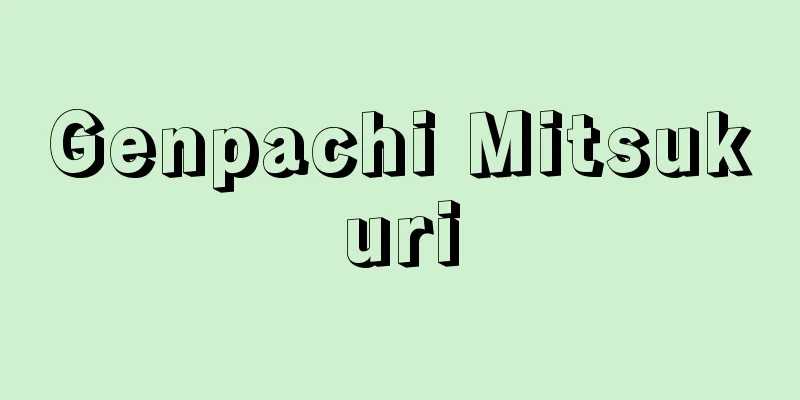
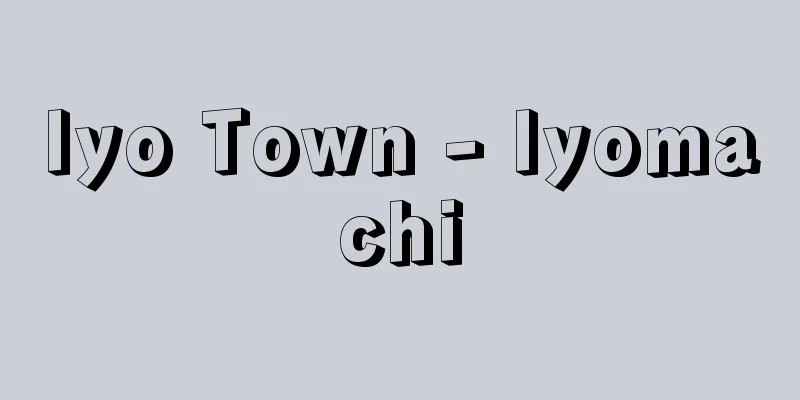
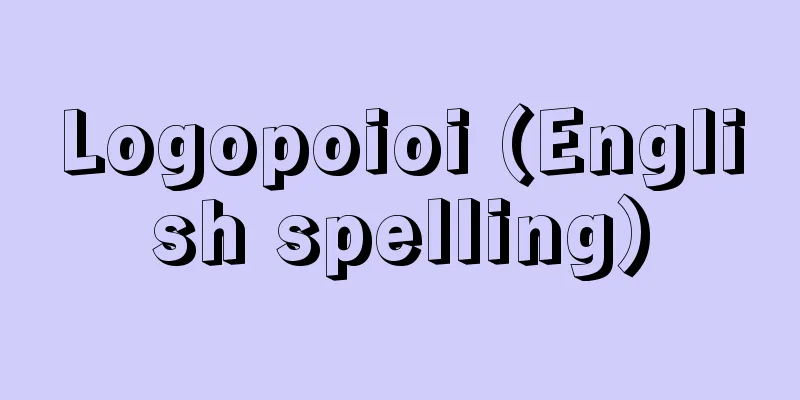

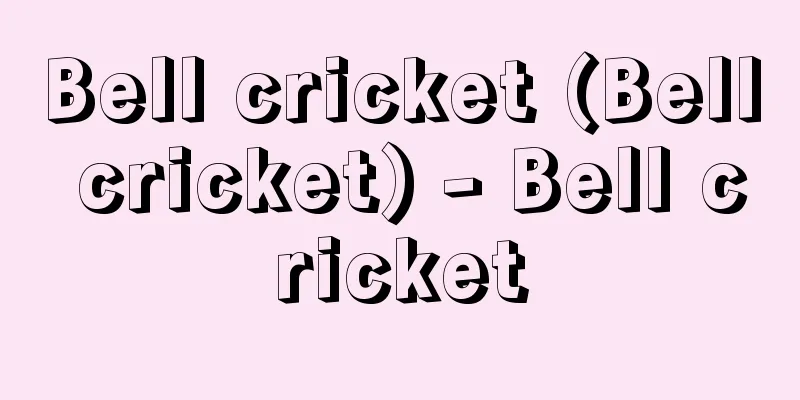
![Tateyama [city] - Tateyama](/upload/images/67cc236311cbd.webp)
